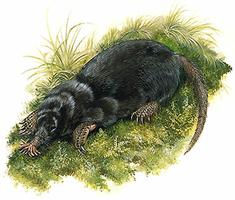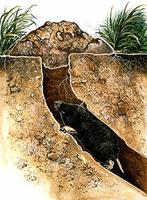Mole, common name for 20-29 species of predominantly burrowing insectivores of family Talpidae restricted to Eurasia and N America. Six species occur in Canada.
Distribution and Habitat
Shrew, coast and Townsend's moles (Neurotrichus gibbsii, Scapanus orarius, S. townsendii respectively) live in extreme southwestern BC; eastern mole (S. aquaticus) in Essex County, Ont; hairy-tailed mole (Parascalops breweri) in forests of Ont and Qué; and the somewhat aquatic star-nosed mole (Condylura cristata) from the Maritimes to Man and N to the boreal forest.
Description
Moles have cylindrical bodies; dense, velvetlike fur; pointed, mobile snouts (with fingerlike appendages in the star-nosed mole); minute eyes and external ears greatly reduced or lacking. The 5-toed feet show varying degrees of adaptation for swimming (Old World water moles) or burrowing.
Reproduction and Development
Moles usually mate in spring; gestation lasts 4-6 weeks; litters average 2-5 young. They may live 3-4 years.
Diet
Canadian species are largely subterranean, preying mainly on soil invertebrates. They may eat their own weight in food daily.

 Share on Facebook
Share on Facebook Share on X
Share on X Share by Email
Share by Email Share on Google Classroom
Share on Google Classroom






